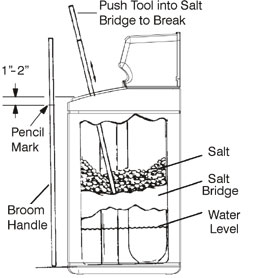Water Softener Salt Bridge – Tip for Homeowners
There is something to learn every day. Here are a few thoughts that I wanted to share with you in regards to water softeners, after talking with my softener guy, Butch.
Out of sight out of mind—who looks into the brine / salt tank of their softening unit anyways? Well you have to put salt in sooner or later and most folks fill’er right up to the top. They figure then they wont have to mess with it for a while if they fill it to the top. Good idea? Not so much…

www.systemsaver.com
Salt bridges can occur when the salt in the softener is kept filled to the top. (See illustration from Morton Website). A salt bridge is when a hard crust forms in the brine tank, and leaves a hollow area below the salt level you can see near the top. It happens when humidity is high; wrong kind of salt is used, or kept too full. (Be sure to use the type of salt your softener recommends). When a bridge forms, it causes a space to form between the water and the salt, and then the salt does not dissolve in the water to make brine, without brine, the resin bed does not regenerate and you have no soft water…
My softener guy recommends that the salt level be maintained at half to two-thirds full. This helps keep things circulating and can keep a bridge from forming. Also it is much easier to break up a bridge if you don’t have to plow through 3 feet of salt.
If you suspect you have a bridge, it will be under the salt at the top. Take a broom handle, or similar tool and push it straight down through the center of the salt. If it stops short of 6” from the bottom you have a bridge. (There is a plastic insert in the bottom of the brine tank; that is why you do not want to go all the way to the bottom of the tank – DO NOT USE ANYTHING SHARP AS YOU MAY PUNCTURE YOUR TANK!). Work the broomstick downward, and back and forth to loosen the bridge, and you should be all set.
There are other less obvious reasons a softener may not be doing the job, but this is one most homeowners can check and it just might do the trick!


